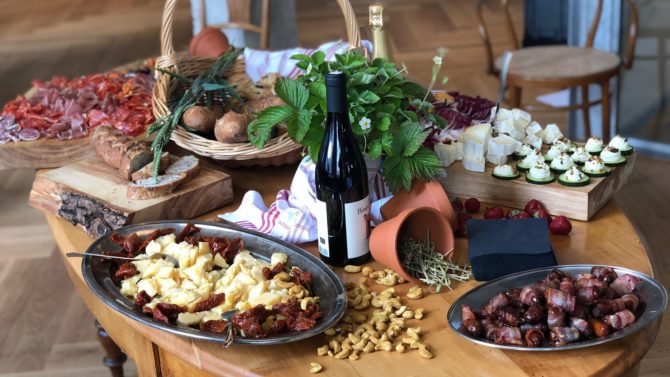Why the French love an apéritif and how you can enjoy the ritual too – especially at Christmas

Though the French are not known to snack between meals, an exception is gladly made for l’heure de l’apéro, one of the country’s most cherished rituals and a perfect example of art de vivre. The apéro usually takes place when the workday draws to an end and friends and family eagerly gather for drinks, nibbles and pleasant conversation. It’s the ultimate way to ease into a relaxed evening or welcome the weekend, but come December, hosting an apéritif dînatoire (the apéro’s better-dressed cousin) is a stress-free alternative to dinner parties, which can be especially daunting at this time of year.

How did the apéro tradition begin?
The origins of the apéro tradition can be traced back to the Greeks and Romans who were already starting their meals with wines sweetened with honey or infused with spices. The word ‘apéro’ is an abbreviation of ‘apéritif”, derived from the late Latin word ‘apertivus’, meaning ‘that which opens’. From the Middle Ages up until the mid-19th century, it was mainly the upper class who were serving drinks before meals (sweet wines blended with plants and herbs) to boost health, stimulate the appetite or ease digestion. When Joseph Dubonnet invented a medicinal drink spiked with quinine (a drug to treat malaria) in 1846, many did not take to its acidic taste. Dubonnet tweaked his concoction and soon enough, it became hugely popular. The pre-dinner tipple was losing its restorative value and well on its way to becoming a convivial tradition loved by everyone.
According to the Syndicat des Apéritifs à Croquer (an association of snack companies formed in 2015), roughly 90% of the French population indulges in the pleasures of an apéro at least once a week. Evening apéros can be taken at home within the family circle, usually before dinner at around six, but local cafés and wine bars are also common meeting places, especially among younger generations. Apéros can precede dinner parties or Sunday lunches. They can be spontaneously organised or planned in advance. There are no rules or stiff etiquette protocols to worry about. The most important thing is relishing the moment. Nevertheless, if you’re lucky enough to be invited by French friends to join in on their beloved cultural tradition, make sure you bring along a bottle of something delicious!

Hosting a festive apéro
If you’re looking to host friends and family this holiday season but the idea of cooking a multi-course dinner sends your nerves into a frenzy, look no further than the apéritif dînatoire. More elaborate than an apéro, it only requires a little planning and has the added advantage that everything can be done well in advance, leaving you plenty of time to relax and enjoy the company of your guests.
An apéritif dînatoire is meant to be a meal on its own. Choose foods with a variety of textures and presentations. For an attractive planche de charcuterie, drape delicate slices of jambon fumé and rosette (salami from Lyon) on a rustic wooden board, scatter with capers or sun-dried tomatoes and drizzle with a fruity olive oil. On another board, serve a thick slice of jambon persillé (parsleyed ham from Burgundy), a slice of foie gras terrine and a piece of pâté en croute made with duck and pistachios.

Mini-quiches, cubes of cake salé and canapés of goose rillettes with a dollop of cranberry sauce are festive and delicious. Make sucettes salées (mini-lollipops) with meatballs, goat’s cheese rolled in finely chopped herbs, or prunes filled with foie gras and wrapped in magret fumé.
Another great idea (especially for New Year’s Eve) is giving your apéritif dînatoire a seafood theme. Blinis with smoked salmon, prawn cocktail verrines, smoked trout or sardine rillettes, squares of pissaladière, a slice of fish terrine with garlic mayonnaise, and a platter of oysters with lemon wedges and mignotte sauce will please and impress your guests.
For drinks, stick with sparkling wines. Not only are they refreshing and help balance the richness of some of the foods, but nothing says celebration more than the pop of a cork!

Apéro top tips
- An apéro is all about simplicity and does not require cooking. The drinks and snacks should not be so heavy that they spoil the appetite. In France, popular apéro nibbles include crisps, pretzels, mixed nuts, crackers and delicate puff pastry snacks such as palmiers.
- For something a little more special, opt for charcuterie classics: unctuous rillettes slathered on baguette, a chunk of pâté accompanied by crunchy cornichons or a jar of confit d’oignons, sausages in assorted flavours, and thinly sliced cured meats. Marinated olives and crudités with anchoïade (anchovy dip) or tapenade are also good choices.
- Though there’s nothing stopping you from serving cubes of Comté or a wedge of brie, keep in mind that cheese can be quite filling and that in France, it’s served as a separate course, before dessert.
- When it comes to drinks, pastis is the most popular apéritif. It is often mixed with syrups to make trendy cocktails such as the perroquet (with mint syrup), the tomate (with grenadine syrup), the violet (with lavender syrup) and the rourou (with strawberry syrup).
- The kir, a speciality from Burgundy traditionally made with one-third blackcurrant liqueur (crème de cassis) and two-thirds Aligoté wine, closely follows pastis on the list of favourite apéritifs. It can be prepared in myriad ways, for example, as a kir pêche (with peach liqueur), kir mûre (with blackberry liqueur), and as a sparkling kir royale with champagne or crémant. Vermouth, Campari, Lillet, Suze or even a gin and tonic are also great choices.
- If serving wine as an apéritif, opt for a glass of bubbly, white wine, rosé or even a sweet wine.
- Non-alcoholic drinks include sparkling water flavoured with lemon, lime or fruit cordials.
Share to: Facebook Twitter LinkedIn Email
More in French food, French wine


